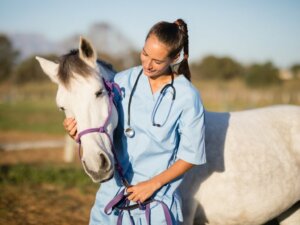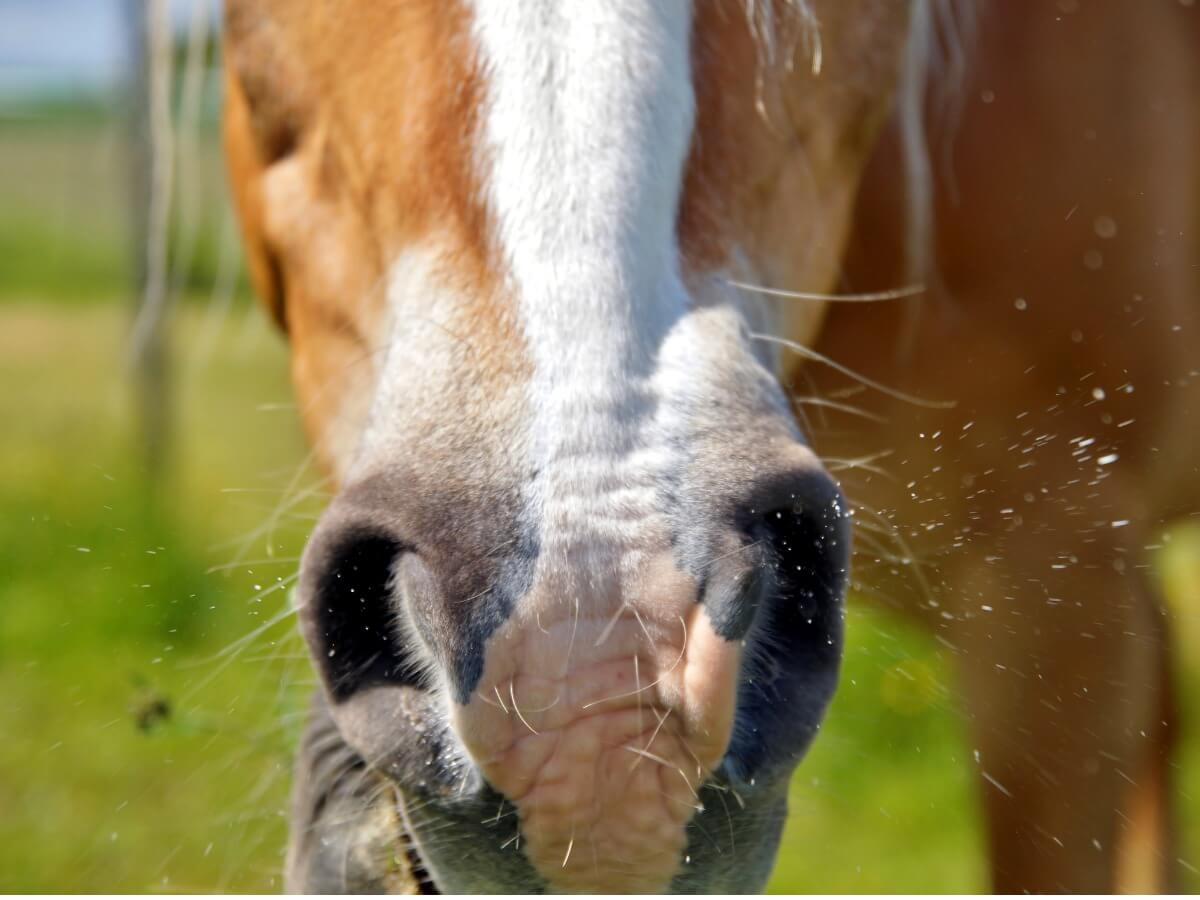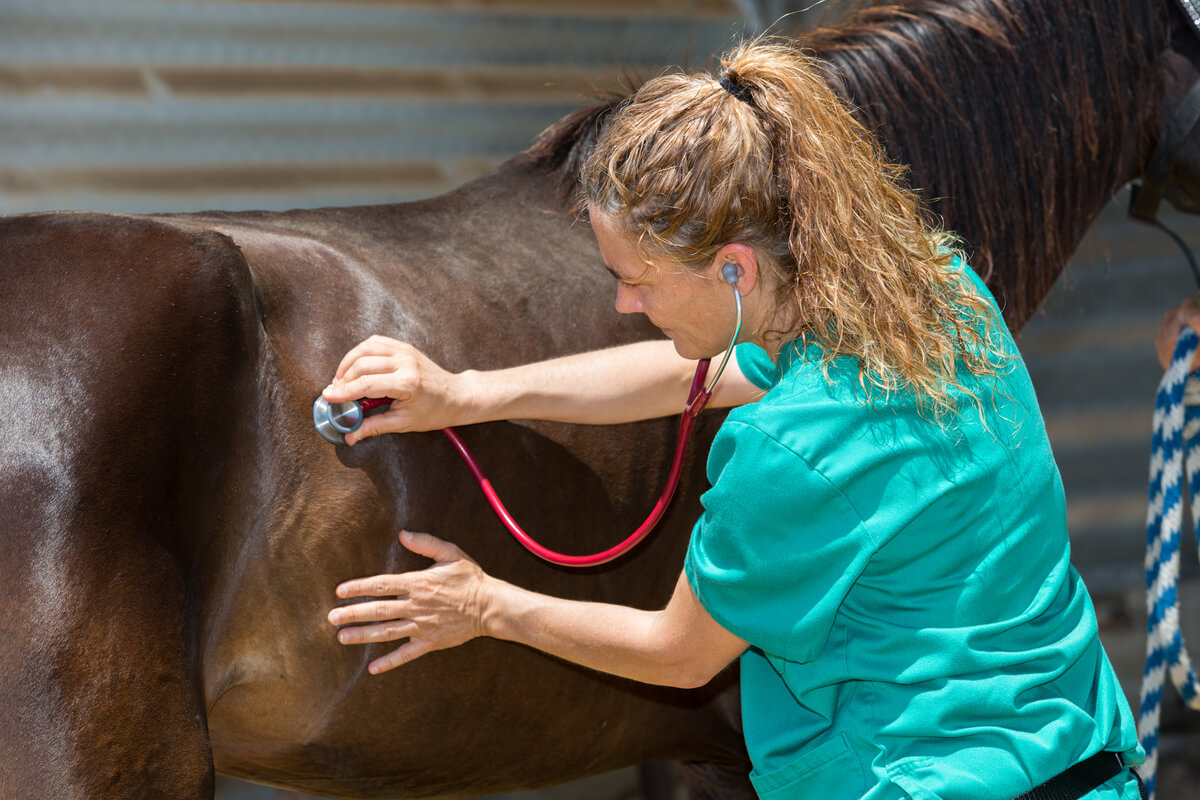What Is Equine Influenza?


Written and verified by the biologist Samuel Sanchez
The term equine influenza (also called horse flu) refers to a highly contagious viral disease of the upper respiratory tract in horses. Its symptoms appear in the form of coughs, conjunctivitis, fever, and nasal discharge, but it doesn’t usually lead to death. Interestingly, it’s estimated that all horses that haven’t been vaccinated or exposed to the virus will become infected at some point.
However, even though the rate of infection is alarming, the mortality rate from this infection isn’t more than 4%. In other words, only foals and horses in poor health prior to infection are at real risk. If you’d like to get to know more about equine influenza, read on.
Is equine influenza due to a virus?
Equine influenza receives several names at the veterinary level, including, as we mentioned earlier, horse flu. These terms will sound familiar to you, as they’re also applicable in human medicine. You won’t be surprised to learn that this pathogen belongs to the group of Influenza A viruses, which also cause disease in people, birds, and other mammals.
As indicated by the Sinobiological portal, it’s estimated that there could be 144 subtypes of the Influenza A virus, although only two of them seem to specialize in infecting horses. So far, strains H7N7 (equine-1) and H3N8 (equine-2) have been detected. Experts believe that H7N7 could have disappeared from the natural environment, as it hasn’t been around for more than 20 years.
So, the main suspect in all cases of influenza in horses is the H3N8 subtype. However, it is known that this pathogen can also infect birds, dogs, cats, and even seals, according to the BBC.
The H3N8 virus is the main cause of respiratory diseases in all horses throughout the world.

Characteristics of the virus
These microorganisms are very simple, like all viruses. Its genetic information consists of RNA segments, which are, in turn, protected from the environment by a lipid bilayer, which gives the pathogen its shape. Meanwhile, the Influenza viruses are categorized into different types according to variants with proteins in their membrane.
As viruses lack almost all the characteristics necessary to be considered cells, they’re rarely included in the groups of living beings. In order to replicate themselves, they have to infiltrate their host’s cell, “hijack” its replicative machinery, and generate copies. When the new viruses enter the extracellular environment, the infected cell dies (lysis).
The proteins embedded in the lipid bilayer that protects the RNA account for almost 50% of the mass of the virus.
Symptoms of equine influenza
According to the MSD Veterinary Manual portal, the incubation period lasts from 1 to 3 days after infection. After this short interval, the following symptoms usually occur:
- High fever, up to 41° C
- Serous nasal discharge
- A strong, dry cough
- General weakness and worse performance
- Difficulty breathing (dyspnea)
- Muscle pain and stiffness of the musculoskeletal system
The most obvious clinical signs don’t last very long (about 2 or 3 days) in immunocompetent horses, as they’re able to cope with the infection quickly and get rid of it. However, as the virus invades the wall of the respiratory epithelium, local destruction of some bronchial structures can occur. Because of this, coughs sometimes last for a few more weeks.
Healthy horses recover fully within a maximum period of 3 weeks.
Possible complications
Due to the damage caused by viral expansion and replication, it usually takes about 21 days for the respiratory epithelium to fully heal. During this stage, horses will be prone to being infected by other opportunistic pathogens, and they can manifest conditions such as pneumonia, pleuropneumonia, and chronic bronchitis. Therefore, it’s best to let the equine rest until it fully recovers.
How is contagion produced?
As the Frontiers of Microbiology journal indicates, this condition is transmitted through droplets, which can be ejected by the sick animal during a cough, sneeze, or whinny. The effectiveness of this virus lies in its resistance, as it can be transmitted through the air over distances of 1 to 2 kilometers.
In addition, the microorganism remains viable for up to 3 days outside the host. Brushes, chairs, caregivers’ clothing, haystacks, waterers, and all facility materials may contain pathogens. If a healthy horse comes into direct contact with any of these elements, it will become infected.
Diagnosis of equine influenza
Ideally, it’s necessary to call the vet when only one horse shows the symptoms cited. In any case, due to how quickly they can catch the virus, it’s almost certain that most of the members of the stable – or even all of them – will become ill at the same time. When this happens, then you can be pretty sure that you’re dealing with an outbreak of equine influenza.
The first step is always to obtain samples of the oral and nasal mucosa of the animal. These samples are taken to the laboratory and, using genetic information amplification techniques – such as the infamous PCR test – the virus genome can be detected. Circulating blood antibody tests are also very useful for this task.
Treatment and prevention
Horses that don’t develop serious symptoms don’t need specific treatment, only supportive care. In any case, the ideal thing is that each sick equine will have one week of rest for each day of fever – in general, three weeks. Those with a high fever can be treated with non-steroidal anti-inflammatory drugs (NSAIDs), always in the doses specified by a veterinarian.
In addition, it may also be necessary to prescribe antibiotics to the animal, especially if the fever lasts more than 4 days and the runny nose is accompanied by purulent discharges. Thus, you can avoid secondary infections that could endanger the life of the sick equine.
There are several vaccines on the market that give horses immunity against equine influenza. If possible, vaccinations are always the best option.

A very common disease
As we said at the beginning, virtually all unvaccinated horses become infected with equine influenza at some point in their life. Although the condition is very irritating, in 2 or 3 weeks the pathology usually resolves on its own and the horse will return to its previous state of health. The death rate doesn’t exceed 4%, and so it isn’t one of the most serious diseases.
However, special care must be taken with immunosuppressed specimens and foals in the herd. These weaker animals can develop much more severe infectious conditions; so to protect them, the best option is to vaccinate every horse in the stables.
All cited sources were thoroughly reviewed by our team to ensure their quality, reliability, currency, and validity. The bibliography of this article was considered reliable and of academic or scientific accuracy.
- New flu virus found in seals concerns scientists. Recogido a 11 de junio en https://www.bbc.com/news/science-environment-19055961
- Influenza Hemagglutinin (HA) subtypes and Flu Virus Strains, SinoBiological (SB). Recogido a 11 de junio en https://www.sinobiological.com/research/virus/influenza-hemagglutinin-subtypes
- Horse flu, MSD. Recogido a 11 de junio en https://www.msdvetmanual.com/respiratory-system/respiratory-diseases-of-horses/equine-influenza
- Singh, R. K., Dhama, K., Karthik, K., Khandia, R., Munjal, A., Khurana, S. K., … & van der Kolk, J. H. (2018). A comprehensive review on equine influenza virus: etiology, epidemiology, pathobiology, advances in developing diagnostics, vaccines, and control strategies. Frontiers in microbiology, 9, 1941.
- Timoney, P. J. (1996). Equine influenza. Comparative immunology, microbiology and infectious diseases, 19(3), 205-211.
- Cullinane, A., & Newton, J. R. (2013). Equine influenza—a global perspective. Veterinary microbiology, 167(1-2), 205-214.
- Cullinane, A., Elton, D., & Mumford, J. (2010). Equine influenza–surveillance and control. Influenza and other respiratory viruses, 4(6), 339-344.
This text is provided for informational purposes only and does not replace consultation with a professional. If in doubt, consult your specialist.